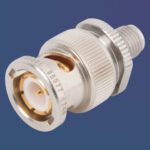Cell Towers Become Less Cluttered
The growing use of cluster RF I/O ports is a big contributor to prevailing trends toward more streamlined cell tower assemblies.
Affordable 5G cell tower upgrades require antennas that can handle more bandwidth in the same tower slots as their 4G predecessors. To achieve this, the needed number of RF ports per antenna I/O panel is soaring. Antenna makers are moving to RF cluster connectors with four or five RF ports to optimize I/O panel utilization and ease of assembly. Antenna designs that can service both low-mid 5G frequencies and legacy frequencies need as many as 36 RF ports. As higher 5G bandwidth use grows, so will the use of cluster connectors and the variety of connector styles employed.
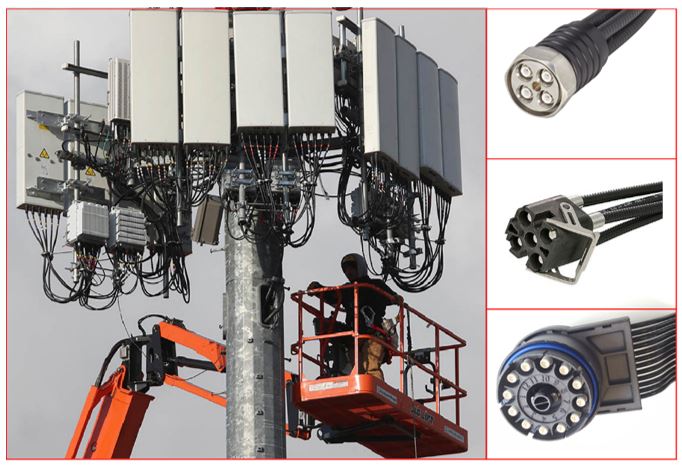
Left: Cell tower installation featuring antenna with related radio units (RRUs) perched nearby.
Right: RF cluster connectors, top to bottom: Rosenberger 4-pin, CommScope 5-pin M-Lock, and SPINNER SMMC-5G 12
Efforts to standardize the cluster connector interface started years ago. In 2019, the Next Generation Mobile Network Alliance (NGMN) issued the white paper “Recommendation for RF Cluster Connector for use in 5G NR 8T8R TDD deployment,” written by a group of connector makers and users, including Amphenol, Deutsch Telecom, Ericcson, HUBER+SUHNER, Nokia, and Telegärtner. The goal was to push towards a common connector interface and agree on the needed technical parameters.
Here is a summary of the four connectors reviewed:

The winner was Huawei’s MQ4/MQ5 connector. What tipped the vote in its favor? The interface’s standardization readiness and proven performance. In part due to China’s early 5G ramp, a significant number of field installations and second sources were in place for Huawei’s patented MQ4/MQ5 interface. In late 2020 the IEC released standards 6318.2 and 6318.3 for the MQ4/MQ5 physical mating interface dimensions, marking a significant benchmark in the formalization of the cluster connector as a cell antenna connector convention.
Today, HUBER+SUHNER, SPINNER, and Rosenberger are among those offering products or assemblies with MQ4/MQ5 connectors. CommScope offers cables (and antenna) with MQ4/MQ5 connectors as well as M-LOC connectors. SPINNER Group has pushed past its initial D-shaped proposal and now offers MQ4/MQ5 assemblies.
Advancing Technology Forces Specification Upgrades
In 2022, the NGMN issued a new report to make the 2019 cluster standard recommendations extensible to include multi-band RRUs operating in frequency bands below 3 GHz that can be paired with the latest FDD antenna equipment.
RRUs process the signals that go to and from the antenna. Multi-band RRUs service more bandwidth with fewer RRUs. But multi-band RRUs means more RF connectors/RRU. The technical requirements released in the report were based in part on the updated power requirements (from existing roadmaps) provided by major OEMs.
The SPINNER SMMC 5G (2.2-5) and the CommScope M-LOC were among the connectors recognized in this NGMN report. Notable here is that the white paper centered on expanded technical requirements and not a specific physical interface.
Implementation of a binding cluster connector interface standard is complicated. Many companies, Huawei, Ericsson, and Nokia, for example, offer sets that combine both the RRUs and antenna. While service providers want a perfect mix-and-match world so they can be agnostic in their upgrades, the service provider also needs a technology roadmap, and in general these call for the accelerating integration of the antenna and RRU functions. Moreover, 5G is redefining the larger network architecture to allow for this integration and orchestrate clusters of smaller antenna alongside large antenna towers.
What’s Next: Expect the Unexpected
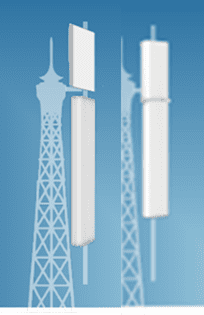 The pace of higher frequency bandwidth introductions will vary by city and depend on yet-to-be-released technologies and standards. Service providers are keeping their options open with antenna upgrades that can pair a module for 4G/lower 5G frequencies and a separate active M-MIMO antenna module (for high-volume, high-frequency transmission) in the same tower slot. (See right, image courtesy of Huawei)
The pace of higher frequency bandwidth introductions will vary by city and depend on yet-to-be-released technologies and standards. Service providers are keeping their options open with antenna upgrades that can pair a module for 4G/lower 5G frequencies and a separate active M-MIMO antenna module (for high-volume, high-frequency transmission) in the same tower slot. (See right, image courtesy of Huawei)
The key advantage of two segment designs is that you can swap out just one module as the mix of bandwidth and available technologies change.
Companies like Ericsson and Huawei have introduced two-part antennas that fit separately or together on a legacy mount. Important to note here is that as the use of bandwidth increases, the fiber-optic ports that now connect the bottom of the RRUs to the network are moving closer to the antenna itself.
Today, compact multi-frequency RRUs can be mounted directly to the back of the antenna. Very short higher-pin RF jumpers are being used for the inter-device connections that were once as long as three meters when more RRUs were used per antenna.
Ericsson introduced a modular antenna featuring cluster connectors using nine 1.5-3.5 RF inserts two years ago. Some of these units feature a SPINNER Group connector with 12 ports in place of the four or five offered in the MQ4/MQ5 design.
The 1.5-3.5 contacts in these “12-fold” RF connectors are 47% smaller than the NEX10 and 2.2-5 (which share the same basic dimensions but a different dielectric and are not intermateable).
The SPINNER connector is noteworthy as it has introduced new axial mating features to address the mating force issues associated with the accumulated insertion force of some contacts. The R/A cable exit facilitates tight packaging that almost resembles a docking station.
What’s more, the SPINNER SMMC connector design is a modular approach, offering the flexibility to accommodate fiber optic as well as RF ports, according to Reiner Berchtold, senior manager of sales and marketing at SPINNER Group.
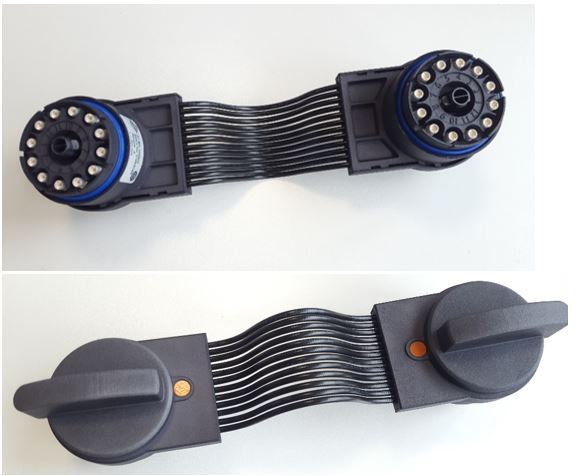
The SPINNER SMMC 5G (2.2-5) and the CommScope M-LOC were among the connectors recognized in this NGMN report. Notable here is that the white paper centered on expanded technical requirements and not a specific physical interface.
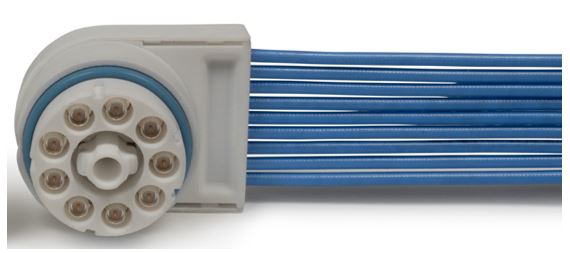
SPINNER cluster connector SMMC-5G 9 (1.5-3.5) featuring four 2.2-5 and nine 1.5-3.5 RF interfaces
As technology evolves, the trend to tighter packaging between the antenna and RRU will continue both on the cell tower and in the small round antenna systems used atop street lights . The use of MQ4/MQ5 and equivalent connectors will grow as they address a specific market need that will expand for the foreseeable future. So will the need for smaller, lower power RF I/O connectors. Along with this trend, the use of multi-pin RF and pseudo coax (pin field) connectors inside the antenna will increase. More and more, the snarly tower designs of today will become a thing of the past.
Like this article? Check out our other RF and Coax and How to Specify articles, our Sensors and Antennas Market Page, and our 2023 and 2022 Article Archive.
Subscribe to our weekly e-newsletters, follow us on LinkedIn, Twitter, and Facebook, and check out our eBook archives for more applicable, expert-informed connectivity content.
- Cell Towers Become Less Cluttered - January 10, 2023
- Market for Smaller LC Duplex Fiber Connectors Makes Big Gains - November 1, 2022
- Twinax Cable is Replacing PCBs Inside Server and Switch Applications - October 4, 2022



